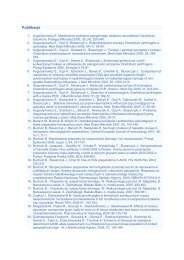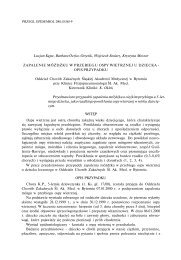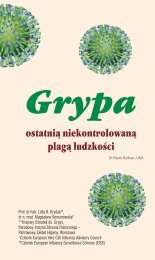94 Jolanta Goździk, Hanna Czajka i inniNr 1INTRODUCTIONHematopoietic stem cell transplantation (HSCT)is an established mode of therapy for a number of malignantand nonmalignant conditions (1). Substantialprogress has been made in the field of HSCT duringthe past 40 years. Despite these advances, infectiouscomplications constitute the major cause of morbidity,re-hospitalization and mortality after successful HSCT.There are several risk factors for infection that stillexist in transplanted patients (2, 3). Impairment of humoraland cell-mediated immunity is seen in almost allHSCT recipients. The degree of immunodeficiency isdetermined by many factors. Reconstitution of immunesystem after HSCT occurs over a period of months toyears (2, 4). Immune response to antigens is low and therisk of infectious complications is high during immunereconstitution. The restoration of humoral immunityfor vaccine-preventable diseases in the autologoussetting and the transfer of donor immunity for vaccinepreventable diseases in the allogeneic setting are bothlimited. Moreover, the recipients usually lose immunememory of exposure to infectious agents and vaccinesaccumulated throughout their lives and antibody titersto vaccine preventable disease decline after HSCT.Several studies have demonstrated low levels of immunityagainst, measles, mumps, rubella, poliovirus,tetanus, Streptococcus pneumoniae, hepatitis A virusand others (5). Additionally, especially in children,serious disease finally treated with HSCT discontinuebasic vaccination program. Therefore after HSCT theyhave none or below protective level of immunity forvaccine-preventable diseases.The objectives of our study were to evaluate therate of immunization before transplantation and thepersistence of vaccine-specific antibodies after HSCTbefore start of revaccination protocol.PATIENTS AND METHODSThirty-eight children (16 girls and 22 boys) treatedby high-dose chemotherapy with autologous (19) andallogeneic (19; 14 from sibling and 5 from unrelateddonors) HSCT were recruited to the study in years 2007-2010. Clinical details of patients are presented in table I.The indication to high-dose chemotherapy followed byautologous transplantation were: Ewing sarcoma (7),neuroblastoma (7), medulloblastoma (2), non-Hodgkinlymphoma (2) and yolk sack tumor (1). The patientswere eligible for allogeneic transplantation becauseof poor prognosis in course of different malignant andnon-malignant diseases: acute lymphoblastic leukemia(10), severe aplastic anemia (3), chronic granulomatousdisease (2), severe combined immunodeficiency (1),juvenile mielomonoblastic leukemia (1), high-IgMsyndrome (1) and Fanconi anemia (1).Tab. I. Clinical characteristicTab. I. Charakterystyka klinicznaHSCTall allogeneic autologousnumber of patients 38 19 19Gendermale 22 12 10female 16 7 9age at diagnosis of primary disease (year)mean 7.0 5.7 8.4median 6.3 4.2 9.8min 0.2 0.2 1.7max 17.5 16.8 17.5age at HSCT (year)mean 8.6 7.8 9.4median 8.5 7.2 10.4min 0.5 0.5 2.4max 18.7 17.3 18.7age at revaccination (year)mean 10.5 9.1 11.8median 9.8 7.9 13.6min 1.2 1.2 3.6max 22.3 18.3 22.3Patients were commenced revaccination if theymet inclusion criteria like as: at least 9 months afterHSCT, good clinical condition, stable engraftment(ANC>1000/μl, platelet count >50000/μl), no symptomsof active infection, no symptoms of active GvHD, notreatment with immunosupresant. Informed consent wasobtained from the patients or their parents. Vaccinationprotocol used was based on the European Blood andMarrow Transplantation group (EBMT), the Centersfor Disease Control and Prevention (CDC) internationalguidelines for vaccination of HSCT recipients as wellas personal experience (6, 7, 8, 9).Specific vaccination history was obtained fromparents and/or the individual vaccination book. The surveyquestions captured information, included the type,number, and schedule of specified vaccines executedbefore transplantation. Information collected was separatedby autologous (A) and allogeneic (B) source ofHSCT. Blood samples (5-10 ml) for serological testingwere collected on the day that revaccination was started.Usually, blood samples were obtained at the same timethat specimens were collected for routine blood tests.Blood was centrifuged, and serum was separated andfrozen in aliquots at -20 0 C on the same day, until thesamples were tested in batches.
Nr 1Status of immunity in children after hematopoietic stem cells transplantation 95The concentration of antibody for the followingantigens: hepatitis B virus (HBV), Heamophilus influenzatype b (Hib), tetanus (T), diphtheria (D) andvaricella (V) were tested using commercial enzymelinked immunosorbent assay (ELISA) kits according tothe instructions of the manufacturer: ETI-AB-AUK-3anti-HBs (DiaSorin, Italy), VaccZyme TM Hib IgG (TheBinding Site, UK), Tetanus and Diphtheria IgG ELISAand VZV IgG/IgM ELISA (Genzyme Vitotech GmbH,Germany).STATISTICAL ANALYSISMeans, medians, ranges and percentages werereported. The results of antibody concentration wascompared between the two groups (allogeneic and autologousHSCT) at the time of revaccination commencedusing the Yates’ c 2 or Fisher exact test. All statisticalanalysis were done using STATISTICA 9.0 with licencefor Jagiellonian University.RESULTSTab. III. Obligatory since 2009 vaccination schedule publishedin 2011 by Polish Ministry of HealthTab. III. Obowiązujący od 2009 r. kalendarz szczepień,opublikowany przez Ministra Zdrowia w 2011r.Age period Vaccine Number of dosesHBV 3BCG 11-yearDt-Tt-P 3Hib 3I-PV 2La-MMR 12-yearDt-Tt-P 1Hib 1I-PV 16-yearDt-Tt-P 1I-PV 110-year La-MMR 114-year Dt-Tt 1HBV - hepatitis B virus, BCG – tuberculosis, Dt – diphtheriatoxoid, Tt – tetanus toxoid, P – pertussis, Hib - Heamophilusinfluenza type b , I-PV - inactivated polio vaccine, La-MMR- live-attenuated measles-mumps-rubella vaccineAThe schedule of obligatory vaccination in Poland,which should be performed in presented group of childrenbefore HSCT was changed in years and is presentedin tables II and III (10,11).Tab. II. Obligatory in Poland since 1991 vaccination scheduleTab. II. Obowiązujący w Polsce od 1991r. kalendarz szczepieńAge period Vaccine Number of dosesHBV 41-yearBCG 1-2Dt-Tt-P 3La-PV 3Measles 12-yearDt-Tt-P 1La-PV 16-yearDt-Tt 1La-PV 17-year BCG 19-year Measles 111-year La-PV 112-year BCG 113-year-girls Rubella 114-year Dt-Tt 1HBV - hepatitis B virus, BCG – tuberculosis, Dt – diphtheriatoxoid, Tt – tetanus toxoid, P – pertussis, La-PV - live-attenuatedpolio vaccine,BBCG – tuberculosis vaccine, HBV – hepatitis B vaccines,Dt – diphtheria toxoid, Tt – tetanus toxoid, P - pertussisvaccine, PV – poliovirus vaccine, Ma – measles vaccine,Mu – mumps vaccine, R - rubella vaccine, Vv – varicellavaccine, Hibc – haemophilus influenzae type b conjugatevaccine, Pn – pneumococcal vaccine, InfV – influenza vaccine,Mn – meningococcal vaccineFig. 1.Ryc.1.Vaccination rate before HSCT in autologous (A)and allogeneic (B) groupOdsetek dzieci zaszczepionych przed autologicznym(A) i allogenicznym (B) przeszczepin komórekkrwiotwórczych HSCT
- Page 1 and 2:
Przegląd EpidemiologicznyK W A R T
- Page 3 and 4:
Index Copernicus 5,58Epidemiologica
- Page 6 and 7:
2 Aneta Kopacz, Anna Bielecka i inn
- Page 8:
4 Aneta Kopacz, Anna Bielecka i inn
- Page 16 and 17:
12 Piotr Grabarczyk, Jolanta Korzen
- Page 18:
14 Patrycja Zalas-Więcek, Eugenia
- Page 23 and 24:
PRZEGL EPIDEMIOL 2012; 66: 19 - 23P
- Page 25 and 26:
Nr 1EM w powiecie hajnowskim 21DYSK
- Page 27 and 28:
Nr 1EM w powiecie hajnowskim 23(3,1
- Page 29:
PRZEGL EPIDEMIOL 2012; 66: 25 - 31P
- Page 33 and 34:
Nr 1Przewlekłe zakażenie HBV u ch
- Page 35 and 36:
Nr 1Przewlekłe zakażenie HBV u ch
- Page 37 and 38:
PRZEGL EPIDEMIOL 2012; 66: 33 - ost
- Page 39 and 40:
Nr 1Nosicielstwo paciorkowca grupy
- Page 41 and 42:
Nr 1Nosicielstwo paciorkowca grupy
- Page 43 and 44:
PRZEGL EPIDEMIOL 2012; 66: 39 - 44P
- Page 45 and 46:
Nr 1Zjawisko efflux w mechanizmie o
- Page 47 and 48: Nr 1Zjawisko efflux w mechanizmie o
- Page 49 and 50: PRZEGL EPIDEMIOL 2012; 66: 45 - 48P
- Page 51 and 52: Nr 1Prognozowanie skuteczności ter
- Page 53 and 54: PRZEGL EPIDEMIOL 2012; 66: 49 - 54P
- Page 55 and 56: Nr 1Skuteczność terapii trójleko
- Page 57 and 58: Nr 1Skuteczność terapii trójleko
- Page 59 and 60: PRZEGL EPIDEMIOL 2012; 66: 55 - 57P
- Page 61: Nr 1Lekooporność a inhibitory pro
- Page 64 and 65: 60 Anita Olczak, Edyta Grąbczewska
- Page 66 and 67: 62 Anita Olczak, Edyta Grąbczewska
- Page 68 and 69: 64 Anita Olczak, Edyta Grąbczewska
- Page 71 and 72: PRZEGL EPIDEMIOL 2012; 66: 67 - 71P
- Page 73 and 74: Nr 1Zakażenia Clostridium difficil
- Page 75: Nr 1Zakażenia Clostridium difficil
- Page 78 and 79: 74 Krzysztof Simon, Justyna Janocha
- Page 80 and 81: 76 Krzysztof Simon, Justyna Janocha
- Page 83 and 84: PRZEGL EPIDEMIOL 2012; 66: 79 - 82P
- Page 85 and 86: Nr 1Profilaktyka przedekspozycyjna
- Page 87 and 88: PRZEGL EPIDEMIOL 2012; 66: 83 - 88P
- Page 89 and 90: Nr 1Standardy leczenia wzw typu C -
- Page 91 and 92: Nr 1Standardy leczenia wzw typu C -
- Page 93 and 94: PRZEGL EPIDEMIOL 2012; 66: 89 - 91S
- Page 95: Nr 1Szczepienia przeciwko wzw typu
- Page 100 and 101: 96 Jolanta Goździk, Hanna Czajka i
- Page 102 and 103: 98 Jolanta Goździk, Hanna Czajka i
- Page 104 and 105: 100 Monika Zawadka, Anna LutyńskaN
- Page 106 and 107: 102 Monika Zawadka, Anna LutyńskaN
- Page 108 and 109: 104 Monika Zawadka, Anna LutyńskaN
- Page 111 and 112: PRZEGL EPIDEMIOL 2012; 66: 107 - 11
- Page 113 and 114: Nr 1Ewolucja polskiego PSO 109lata
- Page 115 and 116: Nr 1Ewolucja polskiego PSO 111- prz
- Page 117 and 118: PRZEGL EPIDEMIOL 2012; 66: 113 - 11
- Page 119 and 120: Nr 1Zastosowania genetyki w zdrowiu
- Page 121: Nr 1Zastosowania genetyki w zdrowiu
- Page 124 and 125: 120 Elżbieta Biernat, Anna Poznań
- Page 126 and 127: 122 Elżbieta Biernat, Anna Poznań
- Page 128 and 129: 124 Elżbieta Biernat, Anna Poznań
- Page 130 and 131: 126 Elżbieta Biernat, Anna Poznań
- Page 132 and 133: 128 Maria Chomyszyn-Gajewska, Agnie
- Page 134 and 135: 130 Maria Chomyszyn-Gajewska, Agnie
- Page 136 and 137: 132 Maria Chomyszyn-Gajewska, Agnie
- Page 138 and 139: 134 Aleksandra Hilt, Ewa Rybarczyk-
- Page 140 and 141: 136 Aleksandra Hilt, Ewa Rybarczyk-
- Page 142 and 143: 138 Aleksandra Hilt, Ewa Rybarczyk-
- Page 144 and 145: 140 Piotr Supranowicz, Mirosław J
- Page 146 and 147: 142 Piotr Supranowicz, Mirosław J
- Page 148 and 149:
144 Piotr Supranowicz, Mirosław J
- Page 150 and 151:
146 Piotr Supranowicz, Mirosław J
- Page 152 and 153:
148 Piotr Supranowicz, Mirosław J
- Page 154 and 155:
150 Piotr Supranowicz, Mirosław J
- Page 156 and 157:
152 Piotr Supranowicz, Mirosław J
- Page 158 and 159:
154 Piotr Supranowicz, Mirosław J
- Page 161 and 162:
PRZEGL EPIDEMIOL 2012; 66: 157 - 16
- Page 163 and 164:
Nr 1Consumer behaviour in OTC medic
- Page 165 and 166:
PRZEGL EPIDEMIOL 2012; 66: 161 - 16
- Page 167 and 168:
Nr 1Prof. zw. dr hab. med. Wiesław
- Page 169 and 170:
Nr 1Prof. zw. dr hab. med. Wiesław
- Page 171 and 172:
PRZEGL EPIDEMIOL 2012; 66: 167 - 16
- Page 173:
Nr 1169WYKAZ RECENZENTÓW PRAC NADE
- Page 176 and 177:
172 Instrukcja dla autorówNr 4w kt
- Page 178:
174 Instrukcja dla autorówNr 4są
















